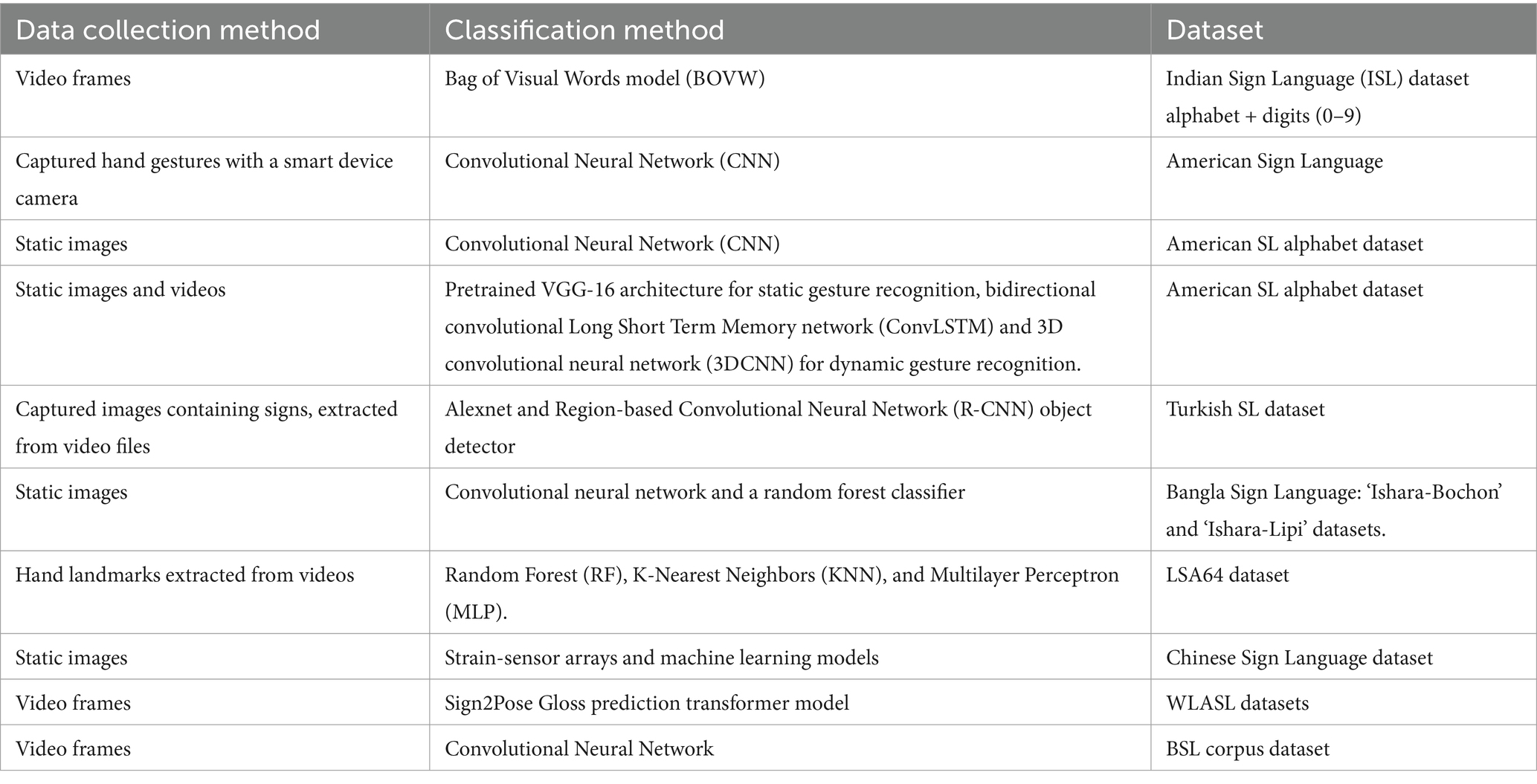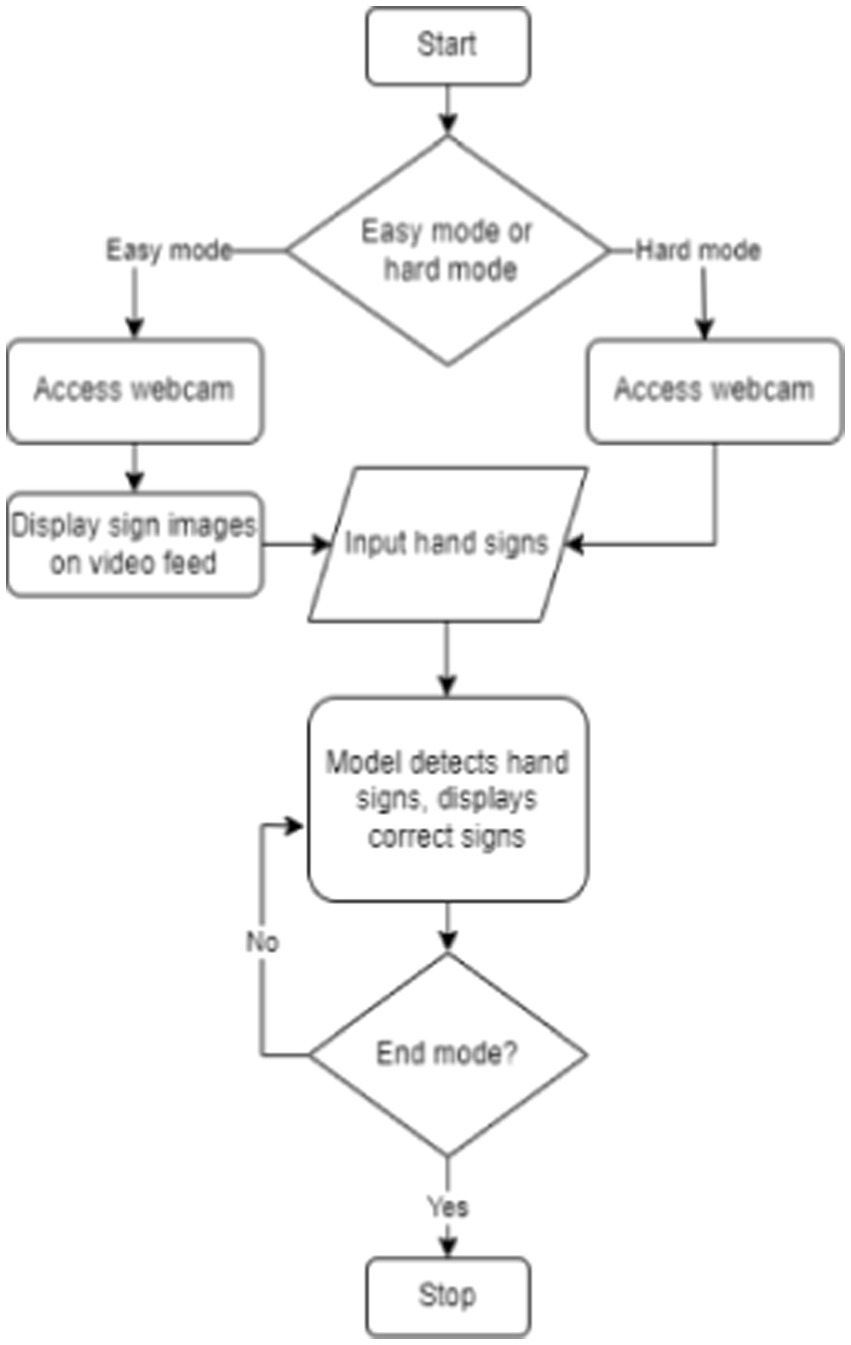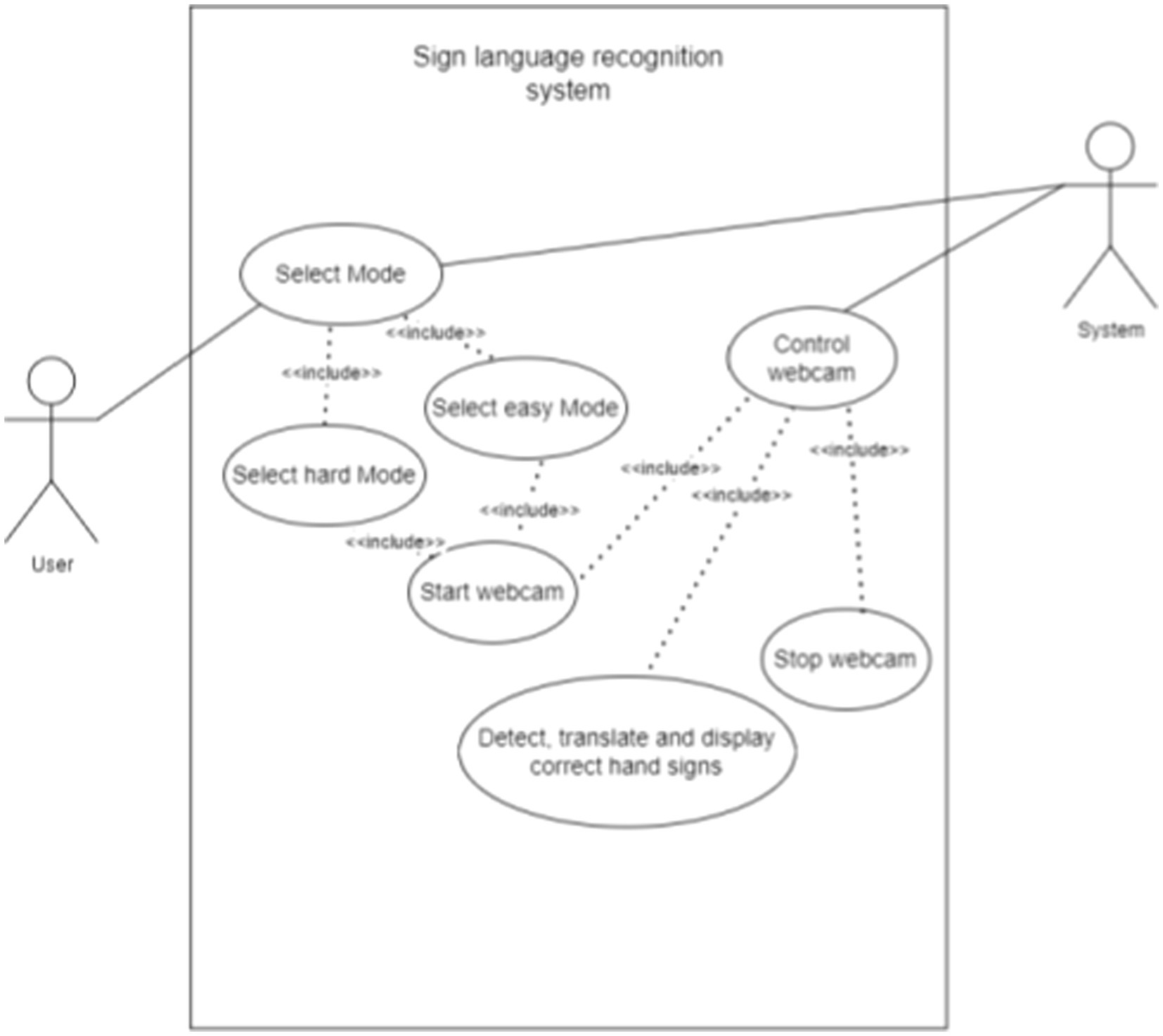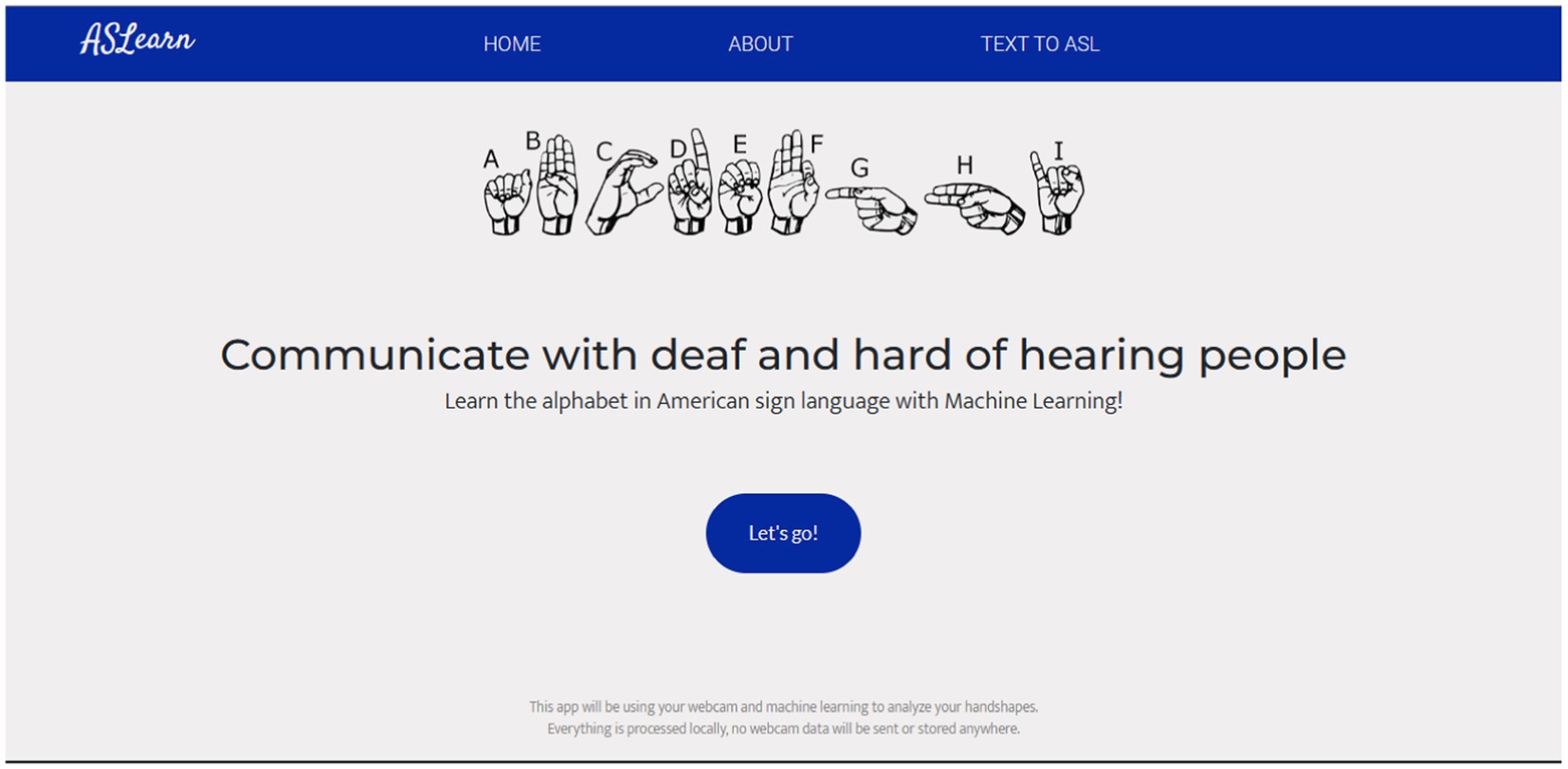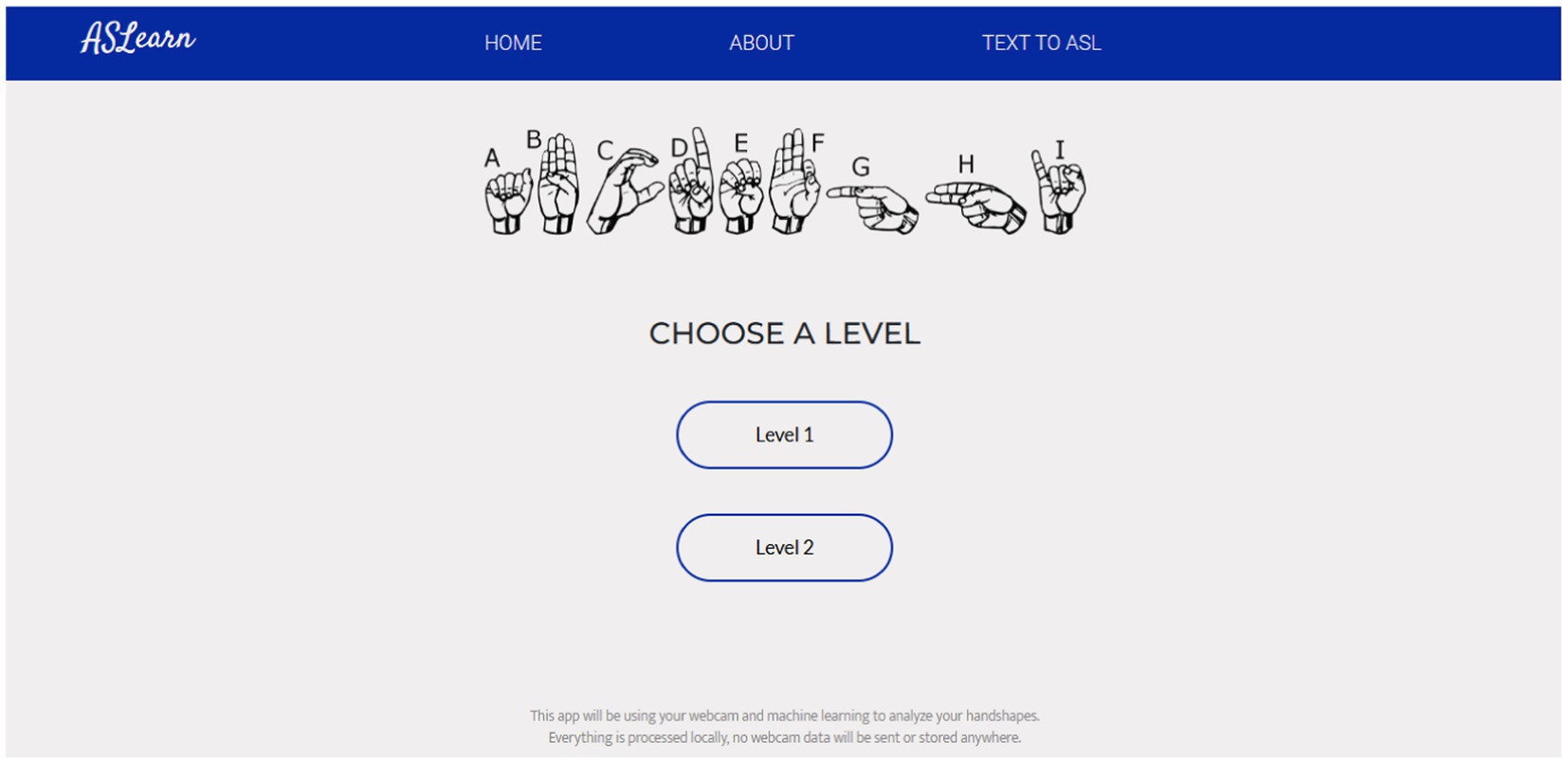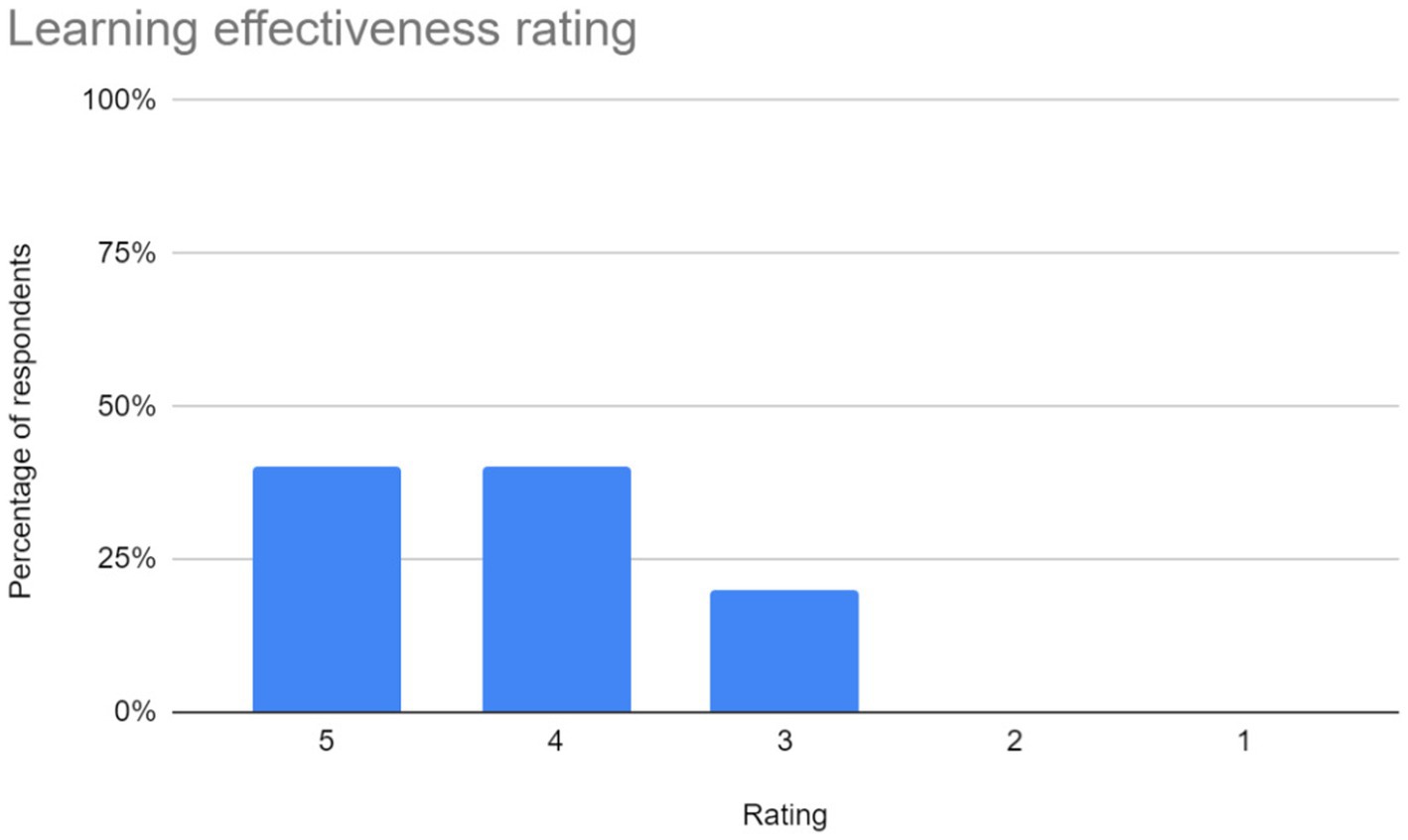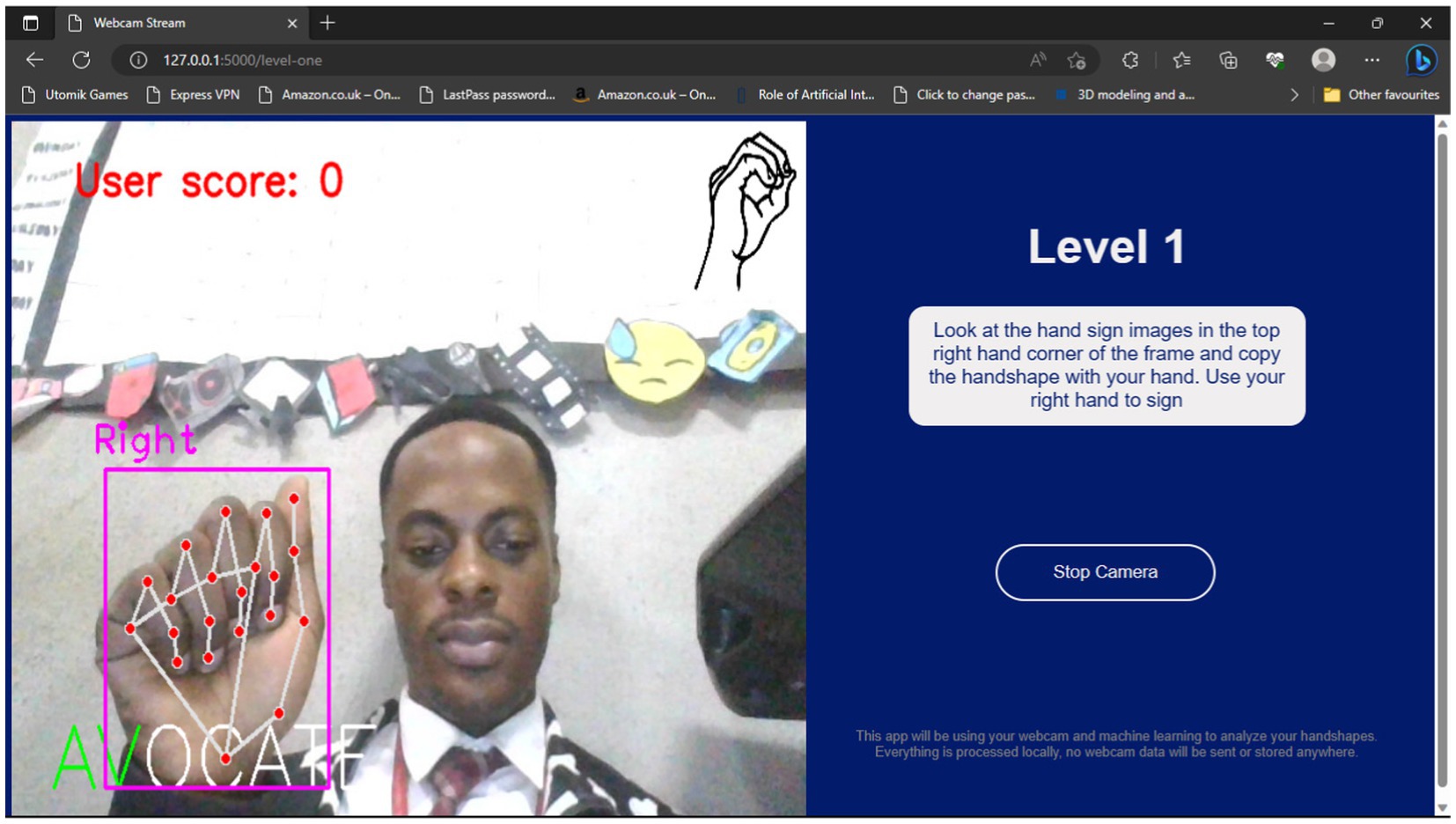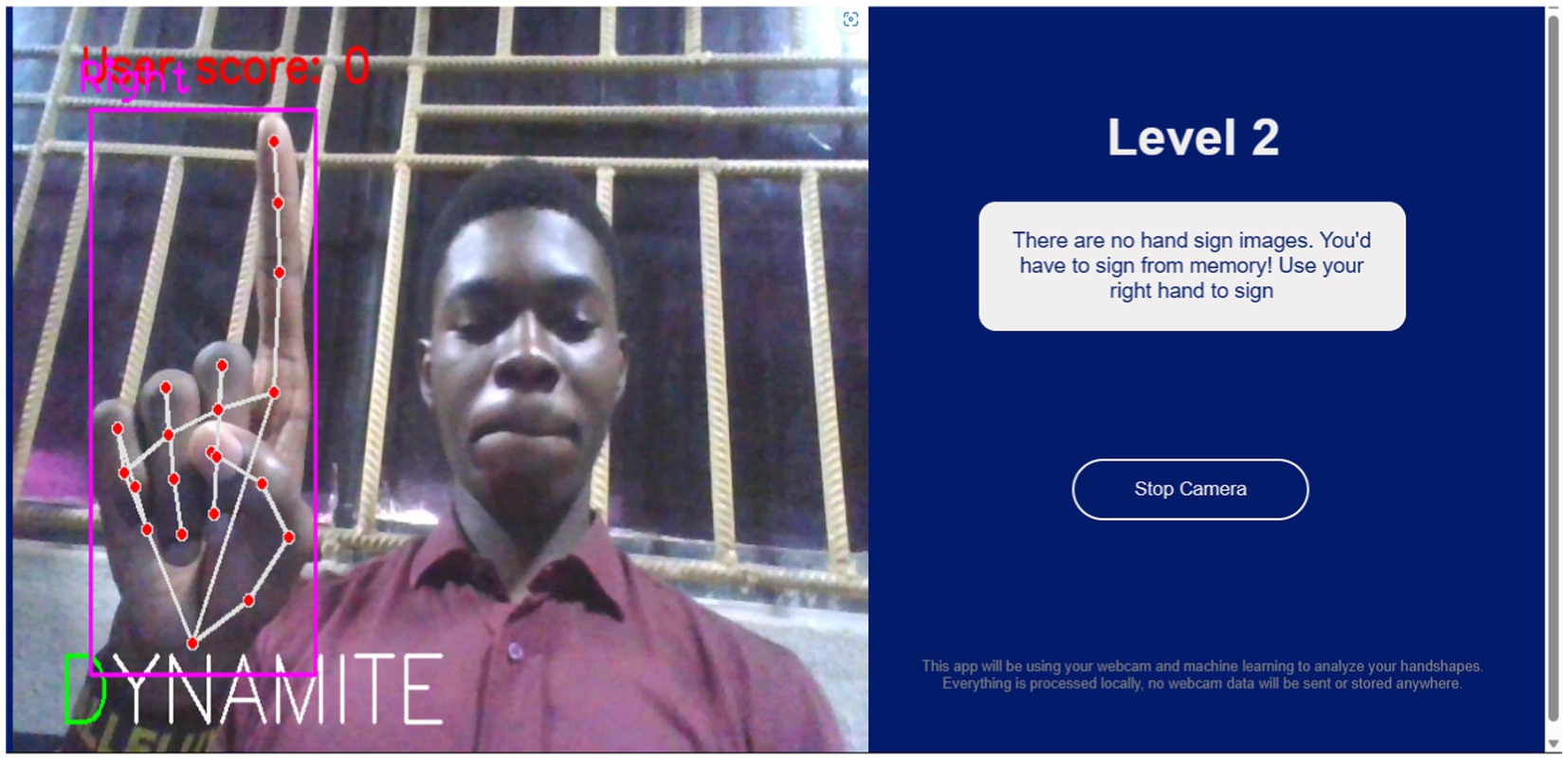- 1Department of Electrical and Information Engineering, Covenant University, Ota, Nigeria
- 2Department of Computer Science and Engineering, University of Bologna, Bologna, Italy
Addressing the increasing demand for accessible sign language learning tools, this paper introduces an innovative Machine Learning-Driven Web Application dedicated to Sign Language Learning. This web application represents a significant advancement in sign language education. Unlike traditional approaches, the application’s unique methodology involves assigning users different words to spell. Users are tasked with signing each letter of the word, earning a point upon correctly signing the entire word. The paper delves into the development, features, and the machine learning framework underlying the application. Developed using HTML, CSS, JavaScript, and Flask, the web application seamlessly accesses the user’s webcam for a live video feed, displaying the model’s predictions on-screen to facilitate interactive practice sessions. The primary aim is to provide a learning platform for those who are not familiar with sign language, offering them the opportunity to acquire this essential skill and fostering inclusivity in the digital age.
1 Introduction
In today’s diverse and interconnected world, fostering effective communication is of paramount importance. A significant portion of the global population faces hearing impairment, which can greatly hinder their ability to engage in meaningful verbal conversations. According to the World Health Organization (WHO), approximately 6% of the world’s population experiences some form of hearing impairment, with nearly 5% requiring therapeutic interventions for “disabling” hearing loss (World Health Organization, 2021; Madhiarasan, 2022; Rodríguez-Moreno et al., 2022). Alarmingly, projections indicate that by the year 2050, as many as 900 million individuals, or one in every ten people, could be affected by debilitating hearing loss (Elsayed and Fathy, 2020; Altememe, 2021).
The impact of hearing impairment extends far beyond the auditory realm, affecting a person’s ability to connect with others, access education, find employment, and participate fully in society (Lee et al., 2022; Al-Hassan et al., 2023). In this context, sign language has emerged as a crucial mode of communication for the Deaf and hard-of-hearing community (Sruthi and Lijiya, 2019; Wadhawan and Kumar, 2020; Ganguly and Deb, 2022). Sign languages, which vary across regions and cultures (Rastgoo et al., 2021; Kındıroglu et al., 2023), provide a visual and gestural means of expressing thoughts and ideas (Thakur et al., 2020; Kodandaram et al., 2021). They offer a bridge to the world for those who may not have access to spoken language. However, in some regions, such as Nigeria, there is no distinctive Nigerian Sign Language (NSL) established for widespread use, despite the existence of over 400 spoken languages and numerous dialects. Consequently, American Sign Language (ASL) is more commonly used in schools for the deaf in Nigeria, while NSL is still in development.
However, learning sign language can be challenging, and access to quality educational resources is often limited (Areeb et al., 2022). Also, acquiring adequately trained translators in any of the numerous signed languages often requires much time and resources (Sharma and Kumar, 2021) and may also hinder the privacy of the hearing-impaired person (James et al., 2022).
In recent years, advances in technology have led to the development of various systems aimed at bridging the communication gap for the deaf and hard-of-hearing community. One notable area of progress is sign language recognition, a field that has garnered significant attention due to its potential to enhance accessibility and inclusion for a marginalized group of individuals. Sign Language Recognition (SLR) has greatly benefited from the integration of machine learning techniques, which have significantly improved the accuracy and efficiency of sign language interpretation by enabling algorithms to adapt and learn from data, leading to more effective communication for individuals with hearing impairments (Abdulkareem et al., 2019; Alausa et al., 2023). Sign Language Recognition (SLR) endeavors to create algorithms and techniques capable of accurately discerning a series of expressed signs and conveying their meanings in the form of written text or spoken language (Kamal et al., 2019).
In our pursuit of this noble goal, we embarked on a journey that commenced with the presentation of our initial findings in a conference paper (Orovwode et al., 2023). In that paper, we introduced a robust sign language recognition system, which represented a significant step forward in sign language technology. We showcased promising results in terms of accuracy and usability, laying the groundwork for future exploration.
Building upon this foundation, this journal article serves as a comprehensive expansion of our research endeavors. While our conference paper offered a glimpse into the potential of sign language recognition, this article delves deeper into the evolution of our system, with a particular emphasis on the novel aspect of deploying the application on the web. We recognized that true progress in accessibility lies not only in the efficacy of our recognition algorithms but also in the ease of access and usability of the technology for a broader audience.
The motivation for our extended research stems from the understanding that, while technology has the potential to break down communication barriers, its impact remains limited if it is not readily accessible to those who need it most. The web, as a ubiquitous platform, offers a unique opportunity to democratize sign language recognition technology, allowing individuals with hearing impairments, educators, caregivers, and the public to access and utilize this valuable tool (Ginsburg, 2020). Therefore, this article chronicles our efforts to adapt and deploy our sign language recognition system on the web, ultimately enhancing its accessibility and usability.
The aim of this paper is to present the development of a web application tailored for the acquisition of the basic American sign language alphabet. The user activates their camera to make hand movements or signs and is shown a word to spell. If the system detects that all the letters of the word have the signed correctly, it gives the user a point. Harnessing the capabilities of machine learning, this application aims not only to expedite the learning process but also to foster inclusivity and bridge the communication gap between the hearing and deaf communities.
The subsequent section of this paper will discuss some related works on the development of sign language recognition systems.
2 Review of related works
Katoch et al. (2022) introduced a technique that employs the Bag of Visual Words model (BOVW) to effectively recognize Indian sign language alphabets and digits in real-time video streams, providing both text and speech-based output. The authors utilized skin color-based segmentation and background subtraction for segmentation. By utilizing SURF features and generating histograms to map signs to corresponding labels, the system employed Support Vector Machine (SVM) and Convolutional Neural Networks (CNN) for classification. Additionally, the paper emphasizes user-friendliness through the development of an interactive Graphical User Interface (GUI).
Baktash et al. (2022) presents a visual-based translator for converting sign language into speech. It employs a hand gesture classification model with Region of Interest (ROI) identification and hand segmentation using a mask Region-based Convolutional Neural Network (R-CNN). The model, trained on a substantial dataset using Convolutional Neural Network (CNN) deep learning, achieved a high accuracy of 99.79% and a low loss of 0.0096. The trained model is hosted on a web server and loaded onto an internet browser using a specialized JavaScript library. Users capture hand gestures with a smart device camera for real-time predictions, addressing communication challenges for individuals unable to speak.
Kasapbaşi et al. (2022) in their paper, contributed to the field of sign language recognition (SLR) through the development of an American sign language recognition dataset and the implementation of a Convolutional Neural Network (CNN) model. By utilizing neural networks, the study focused on interpreting gestures and hand poses of sign language into natural language. The dataset introduced in the research is characterized by its consideration of various conditions such as lighting and distance, setting it apart as a novel addition to the SLR domain. The model demonstrated an accuracy of 99.38% across diverse datasets.
The study conducted by Bendarkar et al. (2021) proposed a comprehensive design and architecture for American Sign Language (ASL) recognition using convolutional neural networks (CNNs). The approach incorporates a pre-trained VGG-16 architecture for static gesture recognition and a complex deep learning architecture featuring a bidirectional Convolutional Long Short Term Memory network (ConvLSTM) and a 3D convolutional neural network (3DCNN) for dynamic gesture recognition. This innovative architecture aims to extract 2D spatiotemporal features. Accuracy tested against hand gestures for ASL letters captured by webcam in real time was determined to be 90%.
The authors (Yirtici and Yurtkan, 2022) proposed a novel method for recognizing characters in Turkish Sign Language (TSL) using a transfer learning approach with a pre-trained Alexnet and a Region-based Convolutional Neural Network (R-CNN) object detector. The method achieved a commendable 99.7% average precision in recognizing TSL signs, demonstrating its efficacy compared to traditional methods. This study is notable for successfully applying transfer learning to TSL and opens avenues for further enhancement in sign image representations.
Das et al. (2023) presented a study on the automatic recognition of Bangla Sign Language (BSL) using a hybrid model comprising a deep transfer learning-based convolutional neural network and a random forest classifier. The proposed model was evaluated on ‘Ishara-Bochon’ and ‘Ishara-Lipi’ datasets, which are multipurpose open-access collections of isolated numerals and alphabets in BSL. With the incorporation of a background elimination algorithm, the system achieved notable accuracy, precision, recall, and f1-score values: 91.67, 93.64, 91.67, 91.47% for character recognition, and 97.33, 97.89, 97.33, 97.37% for digit recognition, respectively.
The authors (Soliman et al., 2023) introduce a recognition system for Argentinian Sign Language (LSA) that leverages hand landmarks extracted from videos within the LSA64 dataset to differentiate various signs. The hand landmarks’ values undergo transformation via the Common Spatial Patterns (CSP) algorithm—a dimensionality reduction technique with a history in EEG systems. Extracted features from the transformed signals are then employed as inputs for diverse classifiers like Random Forest (RF), K-Nearest Neighbors (KNN), and Multilayer Perceptron (MLP). Through a series of experiments, the paper reports accuracy rates ranging from 0.90 to 0.95 for a collection of 42 distinct signs.
Lu et al. (2023) presented a novel wearable smart glove for gesture language communication, addressing limitations in existing solutions for the hearing-impaired. By integrating strain-sensor arrays and machine learning, the glove achieved over 99% accuracy in recognizing gestures, offering real-time feedback and applications across industries like entertainment, healthcare, and sports training. The strain sensors employed SF-hydrogel as the sensing layer, capitalizing on its flexible nature, strong biocompatibility, easy fabrication process, and impressive conductive properties.
Eunice et al. (2023) introduced a systematic approach to address the challenges of gloss prediction in word-level sign language recognition (WSLR) by leveraging the Sign2Pose Gloss prediction transformer model. The proposed method adopted hand-crafted features over automated extraction for improved efficiency and accuracy. Notably, a refined key frame extraction technique using histogram difference and Euclidean distance metrics was introduced to select essential frames. Augmentation techniques and pose vector manipulation were employed to enhance model generalization. YOLOv3 was incorporated for normalization, aiding in signing space detection and hand gesture tracking. Experimental results on WLASL datasets exhibited remarkable achievements, with a top 1% recognition accuracy of 80.9% in WLASL100 and 64.21% in WLASL300, surpassing state-of-the-art approaches. The amalgamation of key frame extraction, augmentation, and pose estimation notably boosted the model’s performance by enhancing precision in detecting subtle variations in body posture, leading to a significant 17% improvement in the WLASL 100 dataset.
The paper (Kumar, 2022) addressed the challenges in recognizing British Sign Language (BSL) fingerspelling alphabet using a Deep learning framework. By employing Convolutional Neural Network (CNN), the work improved upon traditional methods by achieving higher precision, recall, and F-measure percentages. The model’s performance surpassed previous approaches on BSL corpus dataset and webcam videos, reporting a notable accuracy of 98.0% for a broad lexicon of words.
An overview of the research studies that have been discussed can be found in Table 1.
A noticeable gap in the existing literature is the integration of sign language recognition into web-based applications. Prior research has primarily focused on offline or specialized settings, leaving the web application aspect unexplored. This distinct focus is the cornerstone of our work, as we extend our sign language recognition system to the web, addressing a critical need that previous studies have not fully embraced. This expansion not only builds upon prior foundations but also pioneers the accessibility and usability of sign language recognition technology for a broader audience (see Table 2).
3 Methodology
In this section, we delve into the methodology employed to realize the seamless deployment of our sign language recognition system model on the web. Building upon the foundation laid in our previous work (Orovwode et al., 2023), we explore the technical adaptations and innovations necessary to transition our system from its original offline setting to the dynamic and interactive environment of the web.
3.1 Sign language recognition system model (brief recap)
In alignment with the methodology outlined in our previous paper (Orovwode et al., 2023), the development and deployment of our web-based sign language recognition system encompassed several crucial stages, which are summarize below:
3.1.1 Data acquisition
The acquisition of our image dataset involved the use of a laptop camera to capture the images with the help of the Python OpenCV library. The CVzone HandDetector module aided in detecting the signer’s hand in the camera’s field of view. After detection, the hand signs were cropped and resized to a consistent 300 × 300-pixel size using OpenCV. Our dataset consisted of 44,654 images saved as JPG files, with 24 image classes after excluding dynamic signs J and Z. We divided the dataset into a training set (70%) and a test set (30%) for model training and validation, resulting in 14,979 instances in the test set. Sample of the dataset is seen in Figure 1.

Figure 1. Sample of the dataset (Orovwode et al., 2023).
3.1.2 Data pre-processing
The pre-processing stage involved image resizing to 224×224 pixels to suit the model’s requirements and normalization of pixel intensity values. This normalization ensured that all input data shared a similar scale. The datasets were transformed into one-hot encoded vectors using the ‘to_categorical’ function from the Keras library. Additionally, pixel intensity values were adjusted to achieve a mean of 0 and a variance of 1, enhancing computation speed via hardware acceleration.
3.1.3 Model training
We developed our model using the Keras framework, employing a convolutional neural network (CNN) architecture. The model consisted of three convolutional layers with ReLU activation and a max-pooling layer. The number of filters in these layers progressively increased (32, 64, 128). Convolutional outputs were flattened and passed through fully connected layers with ReLU activation for image classification. The output layer, featuring Softmax activation, comprised 24 neurons representing the 24 sign language classes. Model training was conducted for 5 epochs to mitigate overfitting, considering the dataset’s limited size.
3.1.4 Model evaluation
We utilized the test dataset to assess our model’s performance on unseen data. We computed various metrics, including accuracy, precision, recall, and F1-score, to evaluate the model’s effectiveness in sign language recognition. The values obtained are reported in our previous paper. Upon evaluation, the model demonstrated an accuracy level of 94.68%.
3.2 Model deployment
The machine learning model was integrated into a web application to provide an intuitive interface for users to interact with the system. The web application was built using HTML, CSS, and JavaScript for the front-end, and Flask for the back-end. The system’s user interface was created to be easy-to-use and accessible to all users, with a straightforward and intuitive design. Users can interact with the system through their webcam, and the interface provides clear instructions and feedback on the screen. The application was set up to receive input data from the user’s webcam and feed it into the model for real-time prediction of sign language gestures. The output was then displayed on the user’s screen in the form of text and a point is given to the user for each word spelled correctly.
3.2.1 Expanded explanation of system integration
1 Front-end implementation:
• HTML was used to structure the web pages, while CSS is used to style these elements, ensuring a user-friendly interface.
• JavaScript (AJAX): JavaScript, particularly through AJAX, facilitates real-time communication between the client-side and server-side. When a user submits a hand gesture, an AJAX request is sent to the Flask server with the image data.
2 Back-end processing with flask:
• Flask acts as the server-side framework, handling incoming requests and interfacing with the CNN model to process the hand gesture images. The endpoint /predict receives the image data, preprocesses it, and feeds it into the trained CNN model to predict the corresponding ASL letter.
3 CNN model integration:
• The CNN model, implemented in a Python environment, is loaded into the Flask application at runtime. This model processes the input images and returns the predicted ASL letter.
4 Scoring system:
• Each time a user spells a word correctly, the system verifies the sequence of predicted letters against the target word. If all letters match, the user earns a point.
• The scoring logic is implemented on the client side, updating the user’s score in real-time based on the server’s predictions.
5 Development environment:
• The development environment for our web application includes Flask, TensorFlow/Keras for the CNN model, and typical front-end technologies (HTML, CSS, JavaScript).
• We used a virtual environment for Python dependencies management, ensuring that all required libraries (Flask, TensorFlow, etc.) are correctly installed.
The sign language web app follows a specific sequence to generate predictions. Here’s how the process unfolds:
1. User starts by accessing the home page of the app. They are presented with a choice between two modes: easy and hard.
2. Regardless of the mode chosen, the app will utilize the user’s webcam. Users will use their hands to input responses, effectively spelling out words in sign language.
3. If the user selects the easy mode, the screen will display images of hand signs that the user can mimic to spell the given word, shown in white text. However, the screen will not show any hand sign images in the hard mode.
4. The program then processes the user’s input data. It detects the signs made by the user to spell out the word. If the user gets any letters correct, those letters are highlighted in green.
5. Users can continue practicing their word spelling in their chosen mode until they develop confidence in their ability to communicate through sign language accurately.
The flowchart of the process is shown in Figure 2. Figure 3 shows the use case diagram of the application, which illustrates how the components of the application interact.
3.3 Hardware requirements
Below is a detailed list of the hardware components required to run this application.
1. Processor (CPU): 11th Gen Intel(R) Core(TM) i5-1135G7 @ 2.40GHz, 2,419 Mhz, 4 Core(s), 8 Logical Processor(s)
2. Memory (RAM): 8GB to 16GB RAM
3. Graphics Card: Intel(R) Iris(R) Xe Graphics
4. Network Requirements: Must have a strong internet connection.
4 Results and discussion
In this section, we present the outcomes of our efforts to build and deploy the web-based sign language learning application, leveraging the methodologies established in our previous work.
Our simulated model, although slightly lower, still attains a respectable accuracy level based on the comparison of results to those in previous literature. We deployed the model onto the web application based on the favourable results obtained from our model.
The model, once deployed, successfully identified sign language alphabet gestures and proficiently converted them into their corresponding text forms, maintaining a high level of precision. The source code for the application can be found at https://github.com/ibukunOduntan/SignLangApp. Additionally, the application can be accessed at as-learn.com.
Refer to Figure 4 for a depiction of the web application’s homepage. Additionally, Figure 5 showcases the page where users select their preferred difficulty level for engagement.
The average latency per step was calculated to be 64.02 ms/step. Latency indicates the time it takes for the model to make predictions at different time points. Minimizing latency is crucial for ensuring that the system can respond to users’ gestures promptly, contributing to a more responsive and user-friendly experience. The low average latency is indicative of an efficient system that can promptly respond to user input. Figure 6 depicts a brief series of outputs that show the prediction probability and the latency of prediction at each time step.
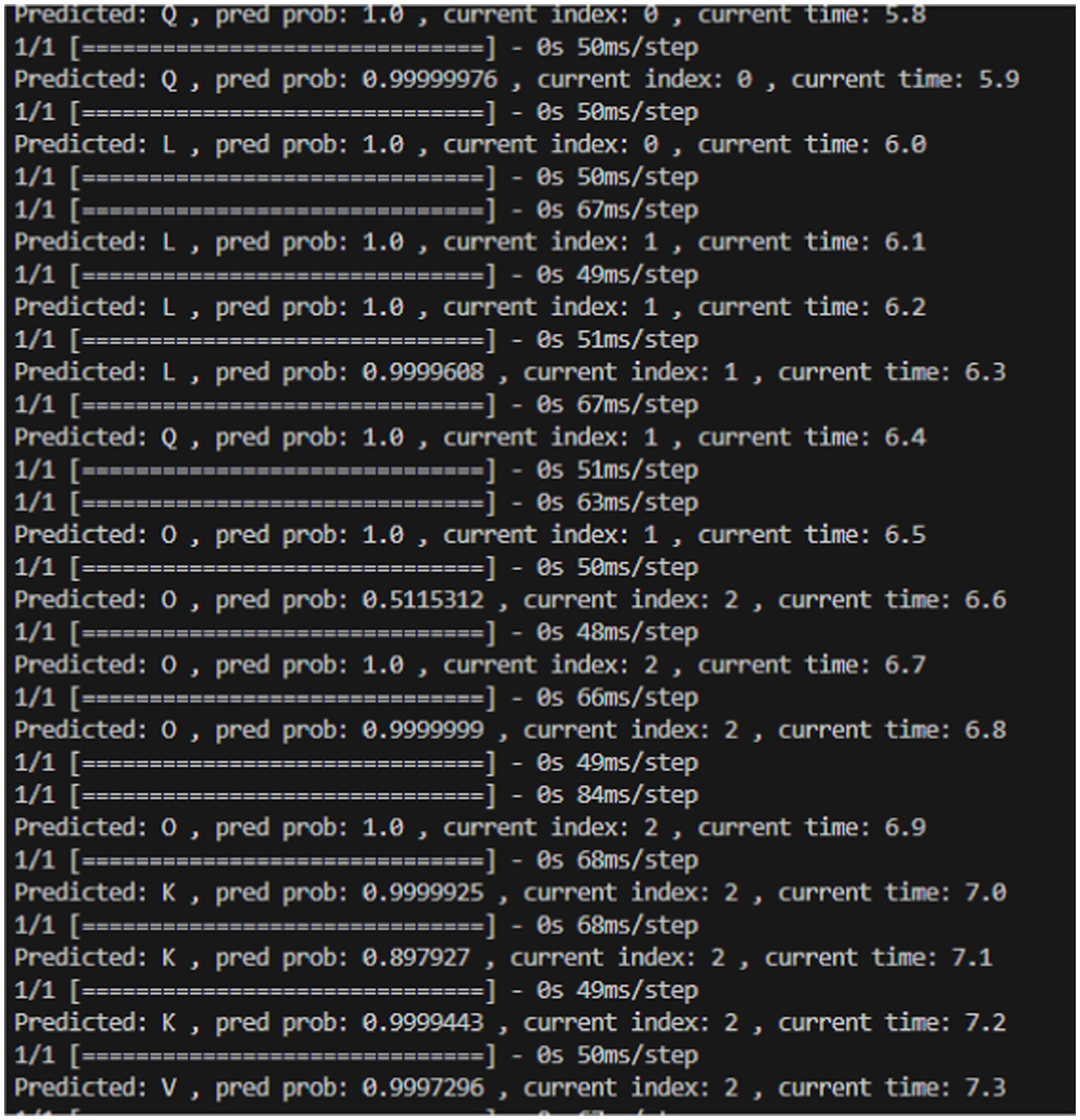
Figure 6. Series of output showing prediction probability and latency of prediction at each time step.
4.1 User feedback
To assess the usability and effectiveness of the sign language learning web application, a structured feedback mechanism was employed. A Google Form was created, soliciting user feedback on various aspects of the application’s performance. Specifically, users were asked to rate the application on a scale from 1 to 5 in the following areas: ease of use, accuracy and performance of the Convolutional Neural Network (CNN) model, latency of the application, and learning effectiveness. Additionally, users were encouraged to provide any additional feedback or suggestions for improvement.
The feedback gathered through the Google Form was analyzed to gain insights into user perceptions and experiences with the application. Barcharts were utilized to visually represent the summarized responses, providing a clear overview of user sentiments across different evaluation criteria. The following subsections provide a detailed analysis of the feedback received in each area:
1. Ease of use: users rated the application based on its navigational simplicity and user-friendly interface. The chart representing user ratings in this aspect is shown in Figure 7.
2. Accuracy and Performance of the CNN Model: The effectiveness of the CNN model in interpreting and recognizing sign language gestures was evaluated by users. The bar chart in Figure 8. depicts user ratings in terms of accuracy and performance.
3. Latency of the application: users assessed the responsiveness and speed of the application in interpreting gestures and providing feedback. “A majority of users reported experiencing latency ranging from mild to severe during their interaction with the application. The reported delays may be attributed to the model’s struggle to generalize across different hand orientations or shapes, possibly due to overfitting to specific patterns observed during training. To address this, expanding the dataset to include a wider variety of signers and hand orientations could help improve the model’s ability to recognize diverse gestures more accurately.
4. Learning effectiveness: feedback on the application’s efficacy in facilitating sign language learning was gathered from users. The chart in Figure 9.
5. Additional feedback: users were given the opportunity to provide supplementary comments, suggestions, and critiques. Suggestions primarily focus on enhancing user experience and functionality. Addressing latency issues and refining the user interface (UI) are paramount for improving overall satisfaction. Additionally, the implementation of offline access would accommodate users with limited internet connectivity. Enhancements in navigation, responsiveness, and clarity are also recommended to ensure an intuitive and efficient user experience.
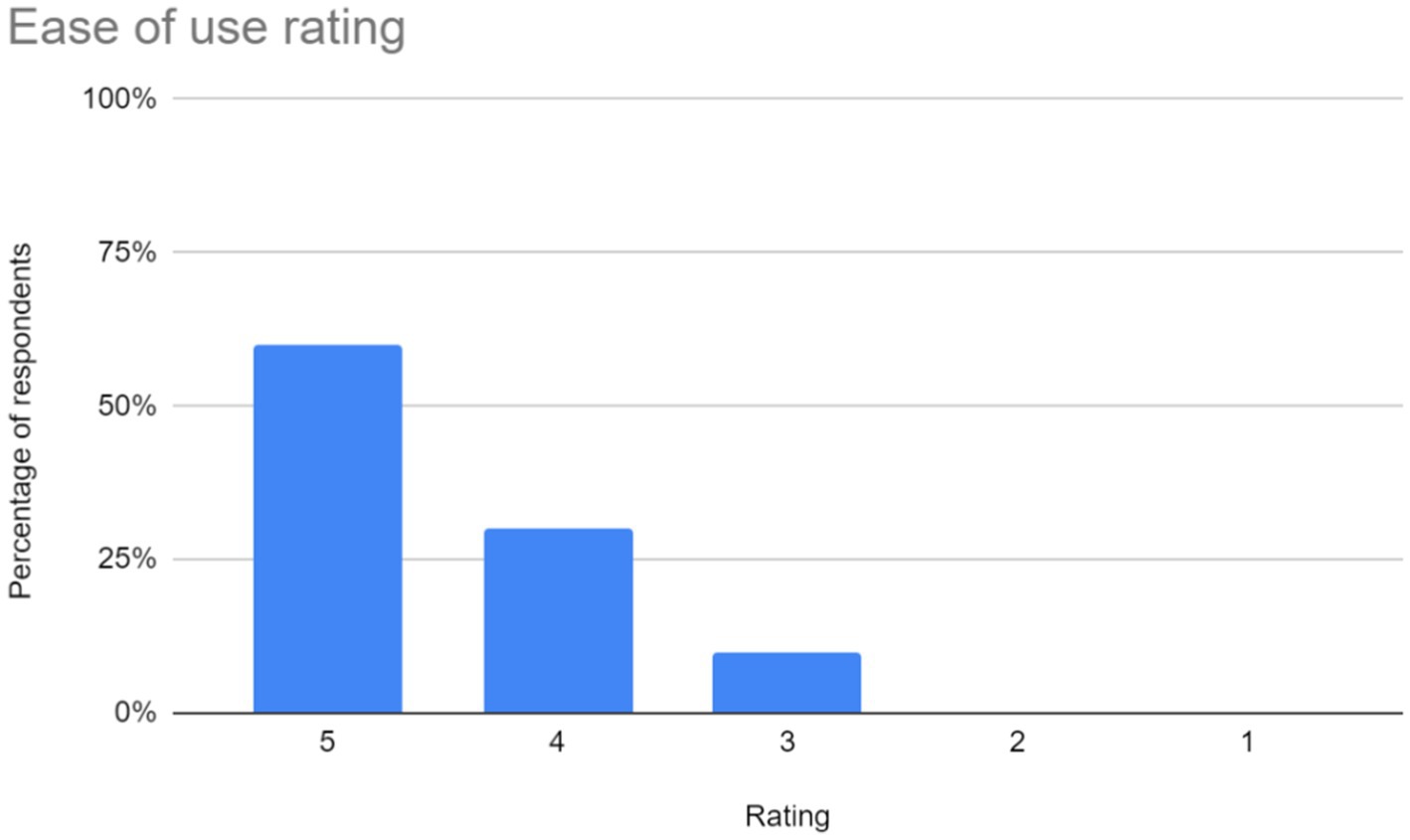
Figure 7. Ease of use ratings for the sign language learning application. The chart in Figure 6 shows that 60% of users rated the application as very easy to use (score of 5), while 30% rated it as easy to use (score of 4). However, 10% found it somewhat less easy (score of 3). Overall, the majority of users found the application to be user-friendly.
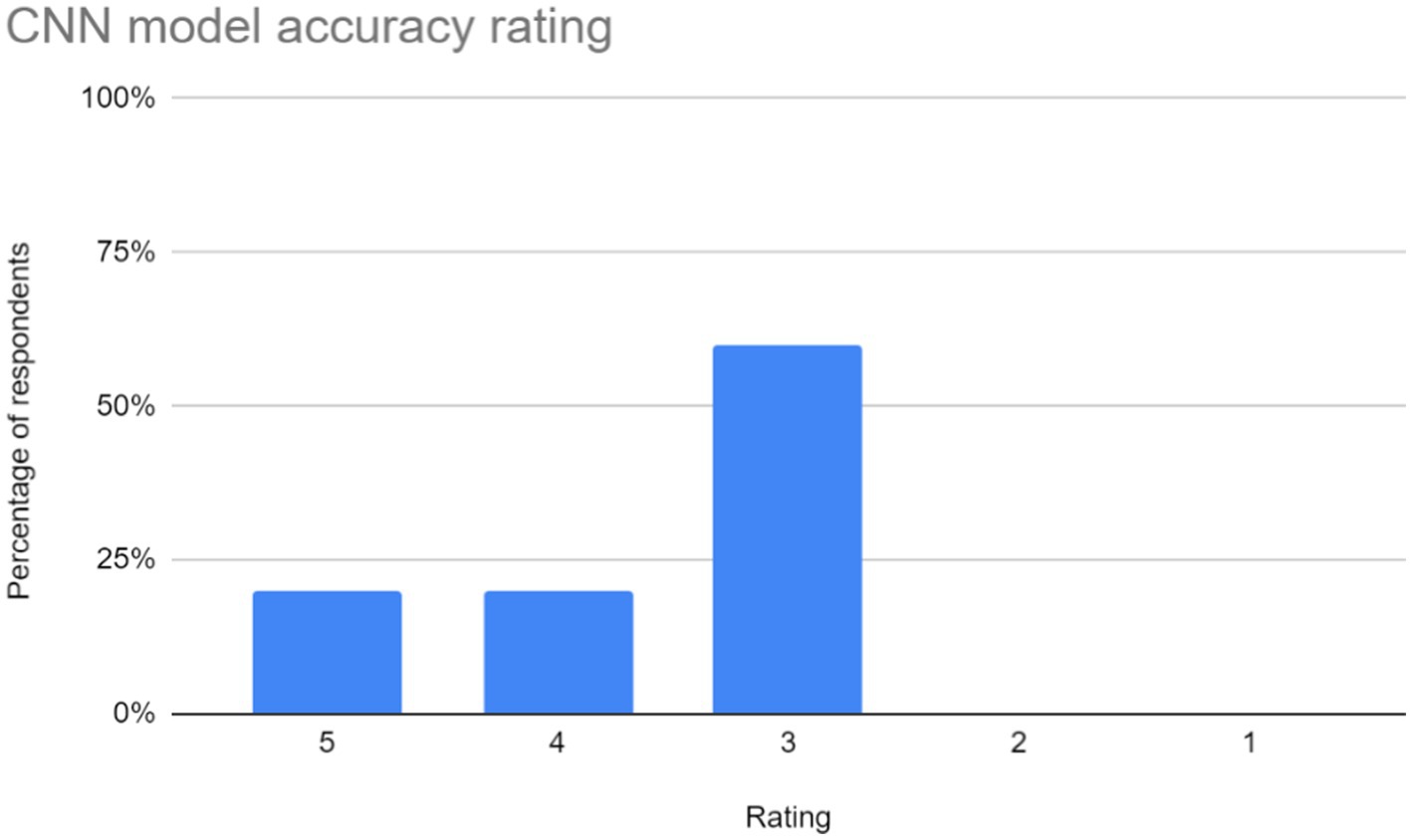
Figure 8. CNN model accuracy ratings for the sign language learning application. The distribution of ratings shows that 20% of respondents rated the CNN model's accuracy as 5, another 20% rated it as 4, and the majority, 60%, rated it as 3. This suggests that there may be room for improvement in terms of consistency or overall performance. Overall, these ratings imply that while some users found the model to be accurate in recognizing sign language gestures, others may have experienced issues or perceived limitations.
Figures 10, 11, respectively, show the Level 1 and Level 2 pages.
5 A comparative analysis
Table 3 shows a detailed analysis of the deployed system compared to previous works.
6 Conclusion
The primary aim of this paper was to extend our previous work on sign language recognition by successfully deploying the application on the web. The web-based system represents a significant advancement in making sign language communication more accessible and user-friendly. We anticipate this work will contribute to the broader accessibility of sign language recognition technology and open new research and application development avenues in this field. The results and discussion section demonstrated the viability of the web-based application, showcasing comparable accuracy levels to previous studies. The low average latency observed in the system’s responsiveness further enhances its user-friendly experience. Visual elements, including screenshots of the application and a flowchart, provided a tangible representation of the research findings.
In charting a course for future endeavours, several avenues for improvement beckon. Firstly, the system’s scope could extend beyond the confines of the ASL alphabet, embracing a wider range of complex sign language gestures to enable more comprehensive communication. Beyond this, the integration of auxiliary assistive technologies, such as speech-to-text, presents an opportunity to create a more holistic communication solution. Additionally, the creation of a dedicated mobile or desktop application could further enhance accessibility, enabling users to engage with the system on the go. Also, by forging partnerships with organizations that cater to individuals with hearing disabilities, the system’s reach and impact can be significantly amplified, thereby fostering broader adoption.
Data availability statement
The raw data supporting the conclusions of this article will be made available by the authors, without undue reservation.
Ethics statement
Written informed consent was obtained from the individual(s) for the publication of any potentially identifiable images or data included in this article.
Author contributions
HO: Supervision, Writing – review & editing. OI: Software, Writing – original draft, Methodology. JA: Software, Writing – original draft, Conceptualization, Visualization, Writing – review & editing.
Funding
The author(s) declare financial support was received for the research, authorship, and/or publication of this article. Funding was received by Covenant University.
Acknowledgments
The authors acknowledge the financial support offered by Covenant University in the publication of this paper.
Conflict of interest
The authors declare that the research was conducted in the absence of any commercial or financial relationships that could be construed as a potential conflict of interest.
Publisher’s note
All claims expressed in this article are solely those of the authors and do not necessarily represent those of their affiliated organizations, or those of the publisher, the editors and the reviewers. Any product that may be evaluated in this article, or claim that may be made by its manufacturer, is not guaranteed or endorsed by the publisher.
References
Abdulkareem, A., Shomefun, T., and Oluwabusola, A. (2019). Web based fingerprint roll call attendance management system. Int. J. Electr. Comput. Eng. 9, 4364–4371. doi: 10.11591/ijece.v9i5.pp4364-4371
Alausa, D. W., Adetiba, E., Badejo, J. A., Davidson, I. E., Akindeji, K. T., Obiyemi, O., et al. (2023). “PalmMatchDB: an on-device contactless Palmprint recognition Corpus” in 2023 IEEE 3rd international conference on power (IEEE: Electronics and Computer Applications (ICPECA)), 318–325.
Al-Hassan, O. M., Bani-Hani, K. E., and Al-Masa’deh, M. M. (2023). Sign language as a means of inclusion: A case study. Int. J. Disabil. Dev. Educ., 1–15. doi: 10.1080/1034912X.2023.2213178
Areeb, Q. M., Nadeem, M., Alroobaea, R., and Anwer, F. (2022). Helping hearing-impaired in emergency situations: A deep learning-based approach. IEEE Access 10, 8502–8517. doi: 10.1109/ACCESS.2022.3142918
Baktash, A. Q., Mohammed, S. L., and Daeef, A. Y. (2022). Sign language translator: web application based deep learning. In AIP conference proceedings (Vol. 2398, No. 1). AIP Publishing.
Bendarkar, D., Somase, P., Rebari, P., Paturkar, R., and Khan, A. (2021). Web based recognition and translation of American sign language with CNN and RNN, vol. 17. Available at: learntechlib.org.
das, S., Imtiaz, M. S., Neom, N. H., Siddique, N., and Wang, H. (2023). A hybrid approach for Bangla sign language recognition using deep transfer learning model with random forest classifier. Expert Syst. Appl. 213:118914. doi: 10.1016/j.eswa.2022.118914
Elsayed, E. K., and Fathy, D. R. (2020). Semantic deep learning to translate dynamic sign language. Int. J. Intell. Eng. Syst. 14, 316–325. doi: 10.22266/IJIES2021.0228.30
Eunice, J., Sei, Y., and Hemanth, D. J. (2023). Sign2Pose: A pose-based approach for gloss prediction using a transformer model. Sensors 23:2853. doi: 10.3390/s23052853
Ganguly, T., and Deb, P. P. (2022) ‘Abstracts of 1st international conference on machine intelligence and system sciences’ 655(November 2021), p. 954993.
Ginsburg, F. (2020). ‘Disability in the digital age’, in Digital anthropology : Routledge, 101–126. Available at: https://www.taylorfrancis.com/chapters/edit/10.4324/9781003085201-8/disability-digital-age-faye-ginsburg
James, T. G., Coady, K. A., Stacciarini, J. M. R., McKee, M. M., Phillips, D. G., Maruca, D., et al. (2022). “They’re not willing to accommodate deaf patients”: communication experiences of deaf American sign language users in the emergency department. Qual. Health Res. 32, 48–63. doi: 10.1177/10497323211046238
Kamal, S. M., Chen, Y., Li, S., Shi, X., and Zheng, J. (2019). Technical approaches to Chinese sign language processing: a review. Piscataway, NJ, USA: IEEE Access. Available at: ieeexplore.ieee.org
Kasapbaşi, A., Elbushra, A. E., al-Hardanee, O., and Yilmaz, A. (2022). DeepASLR: A CNN based human computer interface for American sign language recognition for hearing-impaired individuals. Comput. Methods Prog. Biomed. Update 2:100048. doi: 10.1016/j.cmpbup.2021.100048
Katoch, S., Singh, V., and Tiwary, U. S. (2022). Indian sign language recognition system using SURF with SVM and CNN. Array 14:100141. doi: 10.1016/j.array.2022.100141
Kındıroglu, A. A., Özdemir, O., and Akarun, L. (2023). Aligning accumulative representations for sign language recognition. Mach. Vis. Appl. 34:12. doi: 10.1007/s00138-022-01367-x
Kodandaram, S.R., Kumar, N.P., and Gl, S. (2021) ‘Sign language recognition ’. Turkish Journal of Computer and Mathematics Education.
Kumar, K. (2022). DEAF-BSL: Deep LEArning framework for British sign language recognition, ACM Trans. Asian Low-Resour. Lang. Inf. Process. New York, NY, USA: Association for Computing Machinery.
Lee, W. Y., Tan, J. T. A., and Kok, J. K. (2022). The struggle to fit in: A qualitative study on the sense of belonging and well-being of deaf people in Ipoh, Perak, Malaysia. Psychol. Stud. 67, 385–400. doi: 10.1007/s12646-022-00658-7
Lu, W., Fang, P., Zhu, M. L., Zhu, Y. R., Fan, X. J., Zhu, T. C., et al. (2023). Artificial intelligence–enabled gesture‐language‐recognition feedback system using strain‐sensor‐arrays‐based smart glove. Adv. Intell. Syst. 5:2200453. doi: 10.1002/aisy.202200453
Madhiarasan, M. (2022). A comprehensive review of sign language recognition: different types, modalities, and datasets XX, 1–30.
Orovwode, H., Oduntan, I. D., and Abubakar, J. (2023) ‘Development of a sign language recognition system using machine learning’, in 2023 International Conference on Artificial Intelligence, Big Data, Computing and Data Communication Systems (icABCD). IEEE, pp. 1–8.
Rastgoo, R., Kiani, K., and Escalera, S. (2021). Sign language recognition: A deep survey. Expert Syst. Appl. 164:113794. doi: 10.1016/j.eswa.2020.113794
Rodríguez-Moreno, I., Martínez-Otzeta, J. M., Goienetxea, I., and Sierra, B. (2022). Sign language recognition by means of common spatial patterns: an analysis. PLoS One 17:e0276941. doi: 10.1371/journal.pone.0276941
Sharma, S., and Kumar, K. (2021). ASL-3DCNN: American sign language recognition technique using 3-D convolutional neural networks. Multim. Tools Appl. 80, 26319–26331. doi: 10.1007/s11042-021-10768-5
Soliman, A. M., Khattab, M. M., and Ahmed, A. M. (2023). Arabic sign language recognition system: using an image-based hand gesture detection method to help deaf and dump children to engage in education. J. Facul, Arts Qena 32, 1–28. doi: 10.21608/qarts.2023.192747.1618
Sruthi, C. J., and Lijiya, A. (2019) ‘SigNet: A deep learning based indian sign language recognition system’, Proceedings of the 2019 IEEE international conference on communication and signal processing, ICCSP 2019, pp. 596–600.
Thakur, A., Budhathoki, P., Upreti, S., Shrestha, S., and Shakya, S. (2020). Real time sign language recognition and speech generation. J. Innov. Image Proc. 2, 65–76. doi: 10.36548/jiip.2020.2.001
Wadhawan, A., and Kumar, P. (2020). Deep learning-based sign language recognition system for static signs. Neural Comput. & Applic. 32, 7957–7968. doi: 10.1007/s00521-019-04691-y
World Health Organization (2021). World report on hearing. World Health Organization. Available at: https://www.who.int/publications/i/item/9789240020481.
Keywords: machine learning, sign language recognition, CNN, sign language, American Sign Language (ASL), Python
Citation: Orovwode H, Ibukun O and Abubakar JA (2024) A machine learning-driven web application for sign language learning. Front. Artif. Intell. 7:1297347. doi: 10.3389/frai.2024.1297347
Edited by:
Devendra Singh Dhami, Darmstadt University of Technology, GermanyReviewed by:
Ramalatha Marimuthu, iExplore Foundation for Sustainable Development, IndiaKaterina Zdravkova, Saints Cyril and Methodius University of Skopje, North Macedonia
Copyright © 2024 Orovwode, Ibukun and Abubakar. This is an open-access article distributed under the terms of the Creative Commons Attribution License (CC BY). The use, distribution or reproduction in other forums is permitted, provided the original author(s) and the copyright owner(s) are credited and that the original publication in this journal is cited, in accordance with accepted academic practice. No use, distribution or reproduction is permitted which does not comply with these terms.
*Correspondence: John Amanesi Abubakar, am9obmFtYW5lc2kuYWJ1YmFrYXJAdW5pYm8uaXQ=
 Hope Orovwode1
Hope Orovwode1 Oduntan Ibukun
Oduntan Ibukun John Amanesi Abubakar
John Amanesi Abubakar